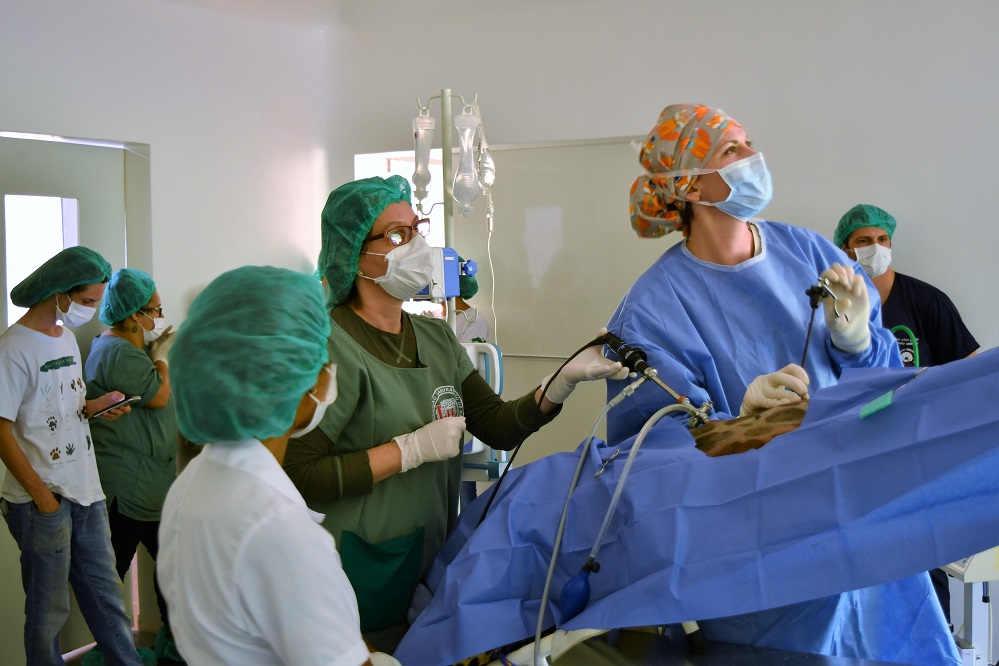International Collaboration Produces First Jaguar Cub Ever Born from Artificial Insemination

Major Scientific Milestone for Conservation
CINCINNATI (March 14, 2019) – On February 16, 2019, the first jaguar cub ever born from artificial insemination (AI) arrived at the Associação Mata Ciliar in Brazil! The birth is a result of an AI procedure performed by scientists from the Cincinnati Zoo & Botanical Garden’s Center for Conservation and Research of Endangered Wildlife (CREW) and represents a major scientific advancement for the conservation of this species. The mother, a wild-born female named Bianca, was one of five jaguars inseminated in early November using laparoscopic AI methods developed and refined by CREW in previous work with other wild cat species.
“By using a systematic research strategy, we were able to improve our understanding of the jaguar’s unique reproductive biology and make species-specific modifications to our standard AI approach,” said Dr. Lindsey Vansandt, CREW’s Theriogenologist and the lead scientist on the project, conducted the AI procedures with the assistance of CREW’s Director of Animal Research Dr. Bill Swanson. “The jaguar is the last of the seven big cat species to be produced by AI. The birth of this cub is an important milestone and invigorates the possibility of using assisted reproduction as a management tool to conserve this iconic cat.”
Following AI with freshly collected semen from a resident wild-born male, Bianca conceived and, after a 104-day gestation period, gave birth to a single viable jaguar cub. Remote video monitoring showed excellent maternal care and nursing by a vigorous cub on the first days following birth. Unfortunately, the cub disappeared from the maternity den two days after birth, presumably consumed by the mother.
“From a scientific perspective, we’re celebrating the fact that the cub was born healthy and that the AI was a success,” said Vansandt. “It’s disappointing that the cub did not survive longer, but it’s not uncommon for carnivores, especially first-time mothers, to behave this way with their offspring.”
Background and Procedure Details
Working with Drs. Cristina Adania, Priscila Yanai, and Jéssica Paulino from the Associação Mata Ciliar, and Dr. Regina Paz from the Federal University of Mato Grosso in Brazil, CREW scientists initiated a three-year study in 2016 to systematically develop assisted reproductive technologies in the jaguar. To more precisely time the insemination relative to the females’ natural estrus cycle, the jaguars were administered an oral progestin (a form of synthetic progesterone) to temporarily suppress ovarian activity beforehand. In a preliminary study, fecal hormone analysis was used to non-invasively monitor the jaguar females’ responses to two different oral progestin doses and adjust the ovarian suppression protocol in preparation for the AI procedures.
Following oral progestin treatment, the female jaguars were injected with two hormones (equine chorionic gonadotropin and porcine luteinizing hormone) to stimulate ovarian follicle growth and ovulation, respectively. In initial jaguar AI attempts in 2017, multiple follicles formed on the ovaries in response to gonadotropin treatment, but few follicles ovulated.
In the latest AI procedures, alterations in injection timing and gonadotropin dosage produced a more consistent ovarian response with the ovulation of multiple follicles. By increasing the number of mature oocytes released from the ovaries, conception and a full-term pregnancy were able to occur, resulting in the birth of the first jaguar cub produced by AI.
Due to poaching and habitat loss and fragmentation, jaguars have declined substantially throughout their natural range. The species has been classified as ‘near threatened’ with a declining population trend in Latin America. Semen collection and AI can be used to propagate genetically-valuable pairs that cannot breed naturally due to behavioral issues or physical impairment. Semen cryopreservation offers even greater advantages by allowing the transfer of genetic material, rather than living animals, between geographically distant populations and ensures that genetic diversity is not lost if the animals die without reproducing. Similarly, the use of frozen semen for AI provides an alternative to importing founder animals from other countries, enhancing the prospects of developing global management programs within zoos. This approach also may promote connectivity between felids living in zoos and the wild, possibly invigorating the genetic diversity of both populations.
###
The world-famous Cincinnati Zoo & Botanical Garden is committed to inspiring visitors to care about wildlife and wild places. It has been rated the #1 attraction locally and one of the top zoos in the nation by Zagat Survey. It has also received rave reviews from Child Magazine, Parents Magazine, USA Today and TripAdvisor. Over 1.8 million people visit the Zoo’s award-winning habitats, and more than 500 animal and 3000 plant species annually. The Zoo, an accredited member of the Association of Zoos & Aquariums (AZA), is internationally known for its success in the protection and propagation of endangered animals and plants and engages in research and conservation projects worldwide. Known as the #GreenestZooInAmerica, the Zoo is doing its part to conserve natural resources that are critical to saving wildlife and its habitats and is committed to greening its daily operations and reducing its impact on the environment through the use of rain gardens, recycled building materials, solar panels and more. The Cincinnati Zoo is a 501(c)(3) nonprofit organization.
About CREW – The Lindner Center for Conservation and Research of Endangered Wildlife (CREW) at the Cincinnati Zoo & Botanical Garden is a global leader in wildlife conservation. Established in 1991 as the first facility of its kind focused on both plant and animal conservation research, CREW is dedicated to “Saving Species with Science”. World renowned for its accomplishments with its four Signature Projects – endangered rhinoceroses, imperiled cats, exceptional plants and threatened polar bears – CREW also provides professional training to the world’s next generation of conservation scientists. CREW’s multi-institutional collaborations and multi-disciplined approaches have a track record of success in expanding our understanding of species biology, improving health and longevity, enhancing propagation and genetic management, and ensuring a future for wildlife.

